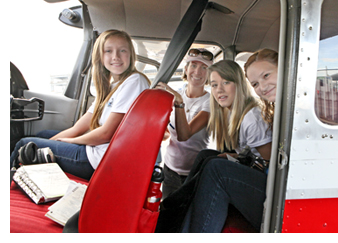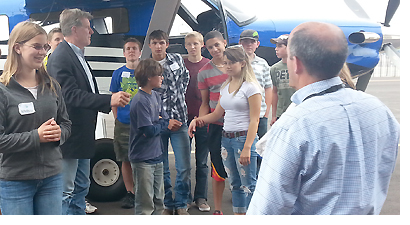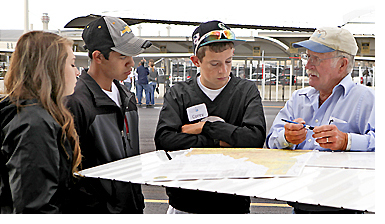

Learning reaches new heights at ACE Academy
Students from throughout Idaho gathered this week at ITD’s Division of Aeronautics for the annual Aviation Career Exploration (ACE) Academy that began Monday (June 24) and concluded. Wednesday.
Twenty-four adventurous Idaho high school students in grades 9 through 12 seized the opportunity to learn about all-things-aviation during the three-day program. The goal of the ACE Academy was to inspire teenagers to consider a career in space or aviation.
 The program began with a balloon satellite project. Under the guidance of local science teacher Paul Verhage, students learned how to design and construct weather balloon satellites capable of collecting aerial data and images. Students were divided into seven teams to create satellites equipped with cameras and tracking devices and prepare for an early morning launch on Wednesday from eastern Oregon.
The program began with a balloon satellite project. Under the guidance of local science teacher Paul Verhage, students learned how to design and construct weather balloon satellites capable of collecting aerial data and images. Students were divided into seven teams to create satellites equipped with cameras and tracking devices and prepare for an early morning launch on Wednesday from eastern Oregon.
Monday also included a lunch presentation by a representative of Utah State University. Tours of the Boise airport, the airport’s control tower and operations center, surveillance and weather screens and baggage area followed. Students also visited the National Interagency Fire Center’s smoke jumper loft.
Students ended their first day by learning how to build small rockets. J.C. Worthen of Tripoli Idaho Rocketry facilitated the session that involved constructing, gluing and painting individual rockets.
Tuesday’s agenda included tours of the Idaho Army and the Air National Guard at Gowen Field, lunch and presentation from a Utah Valley University sponsor and a pre-launch balloon satellite test.
 Before breaking for lunch, students experienced a surprise encounter with Gov. C.L. “Butch” Otter as he passed through the Division of Aeronautics facility on a trip in a new Kodiak aircraft. A tour of Western Aircraft and a career forum wrapped up the day.
Before breaking for lunch, students experienced a surprise encounter with Gov. C.L. “Butch” Otter as he passed through the Division of Aeronautics facility on a trip in a new Kodiak aircraft. A tour of Western Aircraft and a career forum wrapped up the day.
The most exciting day of the ACE Academy came on its final day. Wednesday morning the students’ handcrafted satellites were launched by balloon at 8 a.m. near Rome, Ore. They reached an altitude of 63,000 feet. The satellites were tracked on a website at www.aprs.fi and landed just south of the Boise airport after a three-hour flight. For details about the path of the balloon satellites, click HERE.
Participants embarked upon what many considered to be the most notable event of the entire program – flights on airplanes flown by seasoned volunteer pilots. Following a pre-flight presentation from the Division of Aeronautics Administrator Mike Pape and Dan Etter, an ITD pilot , the students boarded 12 aircraft, many of which were single-engine, two-seat planes. They traveled to Smith Prairie, Mountain Home and the Nampa airport while exploring the beautiful south-central Idaho from the air.
After their flights, students were transported to the Warhawk Air Museum in Nampa where they enjoyed a tour and lunch with a speaker from Embry-Riddle University.
The teenagers visited the Experimental Aircraft Association (EAA) hangar and traveled to Skyline Park in Nampa to witness the launch of the rockets they made earlier in the week.
 The students watched in awe as their rockets shot up to 500 feet in the air. Each student was able to launch his or her rocket at least three times from different launch pads set up at the park.
The students watched in awe as their rockets shot up to 500 feet in the air. Each student was able to launch his or her rocket at least three times from different launch pads set up at the park.
More than 100 launches took place, including a few launches of extra high-powered rockets Worthen brought for the occasion. Some climbed to 1,500 feet.
Pilots and instructors said they were pleased the weather cooperated to make it a terrific event and it was an unforgettable experience for students. Each student took home his or her handcrafted rocket and an abundance of lifelong memories.

Published 6-28-13